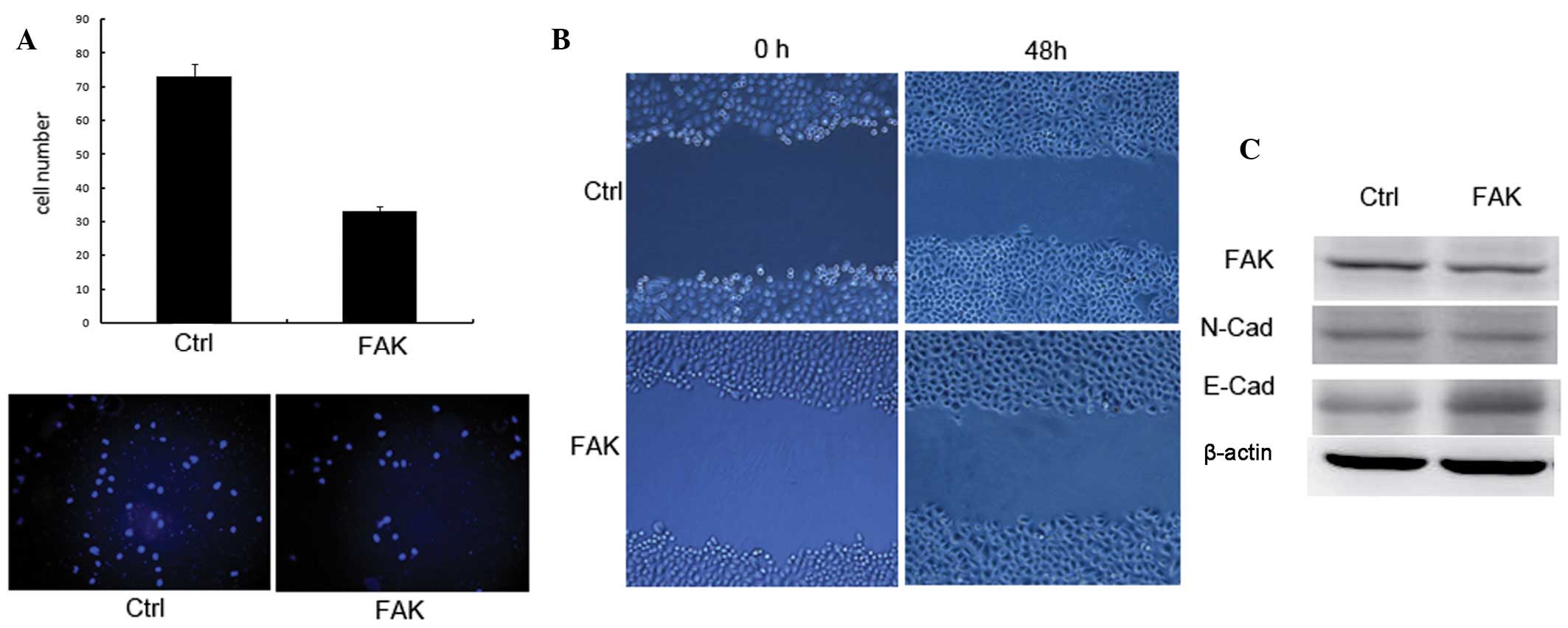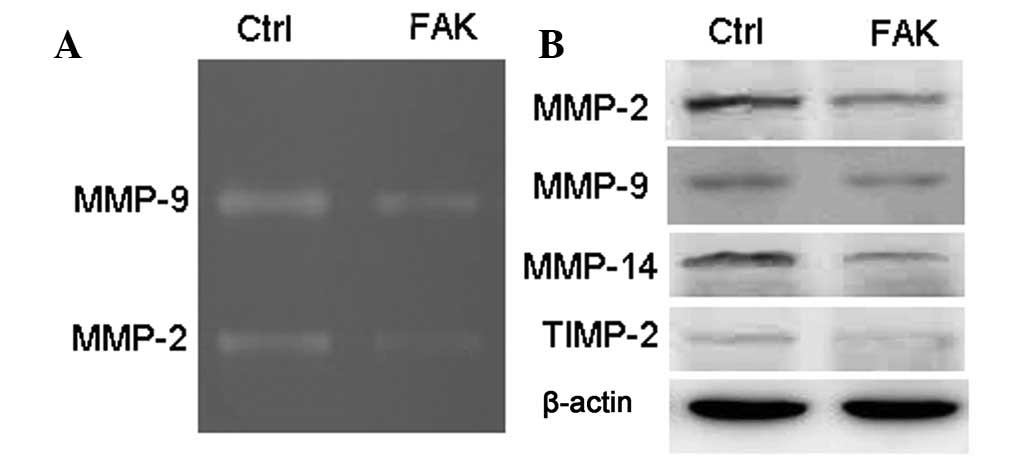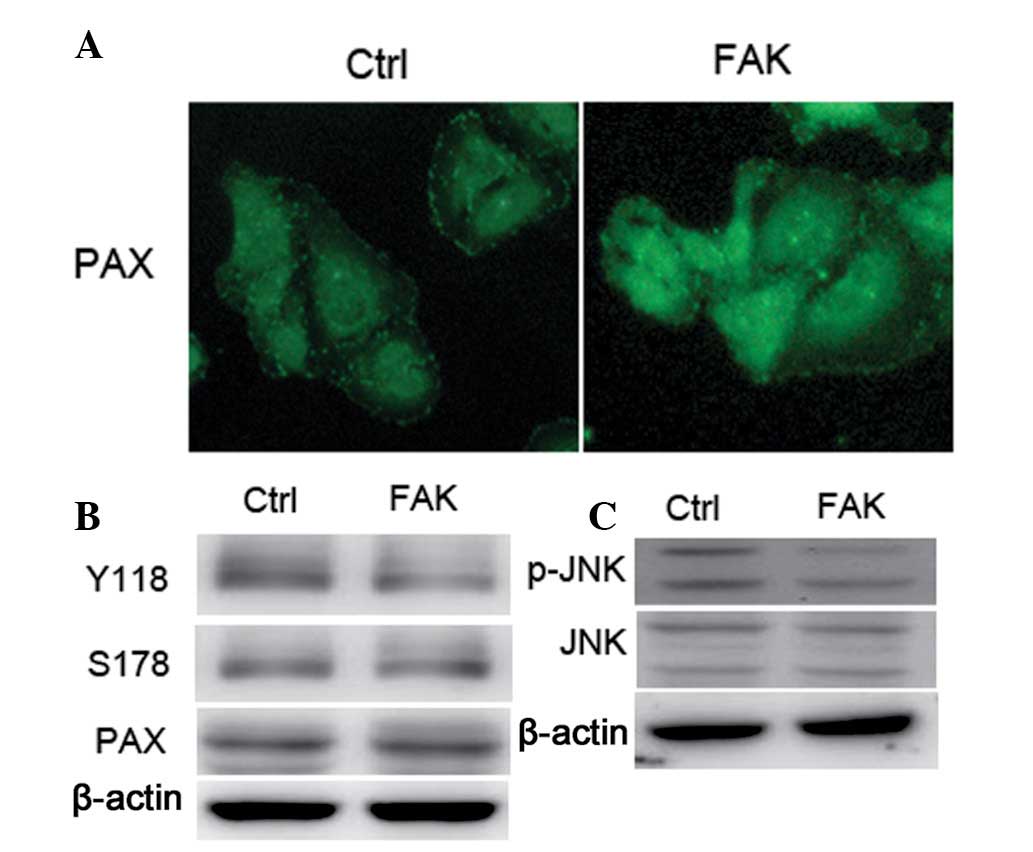|
1
|
Schaller MD, Borgan CA, Cobb BS, et al:
Focal adhesion kinase and associated proteins. Curr Opin Cell Biol.
6:705–710. 1994. View Article : Google Scholar : PubMed/NCBI
|
|
2
|
Mitra SK, Hanson DA and Schlaepfer DD:
Focal adhesion kinase: in command and control of cell motility. Nat
Rev Mol Cell Biol. 6:56–68. 2005. View
Article : Google Scholar : PubMed/NCBI
|
|
3
|
Jelena P and Derrick B: Paxillin
phosphorylation and complexing with Erk and FAK are regulated by
PLD activity in MDA-MB-231 cells. Cell Signal. 24:1531–1540. 2012.
View Article : Google Scholar : PubMed/NCBI
|
|
4
|
Abdelkader H, Maya B, Monique D, et al:
Regulation of focal adhesion dynamics and disassembly by
phosphorylation of FAK at tyrosine 397. J Cell Sci. 118:4415–4425.
2005. View Article : Google Scholar : PubMed/NCBI
|
|
5
|
Vita MG, Sheila F, Baotran TH, et al: A
small molecule focal adhesion kinase (FAK) inhibitor, targeting
Y397 site: 1-(2-hydroxyethyl)-3, 5, 7-triaza-1-azoniatricyclo
[3.3.1.1(3,7)]decane; bromide effectively inhibits FAK
autophosphorylation activity and decreases cancer cell viability,
clonogenicity and tumor growth in vivo. Carcinogenesis.
33:1004–1013. 2012.PubMed/NCBI
|
|
6
|
Tanja P, Virginia E, Kai K, et al: Sulfur
mustard induces differentiation in human primary keratinocytes:
Opposite roles of p38 and ERK1/2 MAPK. Toxicol Lett. 204:43–51.
2011. View Article : Google Scholar : PubMed/NCBI
|
|
7
|
Hochwald SN, Nyberg C, Zheng M, et al: A
novel small molecule inhibitor of FAK decreases growth of human
pancreatic cancer. Cell Cycle. 8:2435–2443. 2009. View Article : Google Scholar : PubMed/NCBI
|
|
8
|
Berger S, Dyugovskaya L, Polyakov A and
Lavie L: Short-term fibronectin treatment induces endothelial-like
and angiogenic properties in monocyte-derived immature dendritic
cells: Involvement of intracellular VEGF and MAPK regulation. Eur J
Cell Biol. 91:640–653. 2012. View Article : Google Scholar
|
|
9
|
Tanjoni I, Walsh C, Uryu S, et al:
PND-1186 FAK inhibitor selectively promotes tumor cell apoptosis in
three-dimensional environments. Cancer Biol Ther. 9:764–777. 2010.
View Article : Google Scholar : PubMed/NCBI
|
|
10
|
Beierle EA, Ma X, Stewart J, et al:
Inhibition of focal adhesion kinase decreases tumor growth in human
neuroblastoma. Cell Cycle. 9:1005–1015. 2010. View Article : Google Scholar : PubMed/NCBI
|
|
11
|
Broughton G 2nd, Janis JE and Attinger CE:
The basic science of wound healing. Plast Reconstr Surg. 117(7
Suppl): 12S–34S. 2006. View Article : Google Scholar : PubMed/NCBI
|
|
12
|
Creighton CJ, Chang JC, Rosen JM, et al: A
Gene Expression Signature Associated with “K-Ras Addiction” Reveals
Regulators of EMT and Tumor Cell Survival. Cancer Cell. 15:489–500.
2009.
|
|
13
|
Bannasch P, Zerban H and Mayer D: The
cytoskeleton in tumor cells. Pathology. 175:196–211. 1982.
|
|
14
|
Stetler-Stevenson WG, Aznavoorian S and
Liotta LA: Tumor cell interactions with the extracellular matrix
during invasion and metastasis. Annu Rev Cell Biol. 9:541–573.
1993. View Article : Google Scholar : PubMed/NCBI
|
|
15
|
Turner CE: Paxillin and focal adhesion
signalling. Nat Cell Biol. 2:E231–E236. 2000. View Article : Google Scholar : PubMed/NCBI
|
|
16
|
Chen J and Gallo KA: MLK3 Regulates
Paxillin Phosphorylation in Chemokine-Mediated Breast Cancer Cell
Migration and Invasion to Drive Metastasis. Cancer Res.
72:4130–4140. 2012. View Article : Google Scholar : PubMed/NCBI
|
|
17
|
Ludmila TT, Plamen IP, Daniel K, et al:
Endosonographic assessment of rectal cancer after neoadjuvant
radiotherapy. Med Ultrason. 14:19–23. 2012.PubMed/NCBI
|
|
18
|
Tankova L, Stoilov G, Kovatchki D, et al:
Comparative evaluation of angiogenesis in rectal cancer using
Doppler ultrasound and immunohistochemical assessment. Compt Rend
Acad Bulg Sci. 63:163–166. 2010.
|
|
19
|
Sudakoff GS, Gasparaitis A, Michelassi F,
et al: Endorectal color Doppler imaging of primary and recurrent
rectal wall tumours: Preliminary experience. AJR Am J Roentgenol.
166:55–61. 1996. View Article : Google Scholar : PubMed/NCBI
|
|
20
|
Xiaoban X, Lijun Z, Caleb M, Reyes, et al:
APPL1 mediates adiponectin-stimulated p38 MAPK activation by
scaffolding the TAK1-MKK3-p38 MAPK pathway. Am J Physiol Endocrinol
Metab. 300:E103–110. 2011. View Article : Google Scholar : PubMed/NCBI
|
|
21
|
Ito R, Oue N, Zhu X, et al: Expression of
integrin-linked kinase is closely correlated with invasion and
metastasis of gastric carcinoma. Virchows Arch. 442:118–123.
2003.PubMed/NCBI
|
|
22
|
Owens LV, Xu L, Dent GA, Yang X, et al:
Focal adhesion kinase as a marker of invasive potential in
differentiated human thyroid cancer. Ann Surg Oncol. 3:100–105.
1996. View Article : Google Scholar : PubMed/NCBI
|
|
23
|
Miyazaki T, Kato H, Nakajima M, et al: FAK
overexpression is correlated with tumour invasiveness and lymph
node metastasis in oesophageal squamous cell carcinoma. Br J
Cancer. 89:140–145. 2003. View Article : Google Scholar : PubMed/NCBI
|
|
24
|
Masson V, de la Ballina LR, Munaut C, et
al: Contribution of host MMP-2 and MMP-9 to promote tumor
vascularization and invasion of malignant keratinocytes. FASEB J.
19:234–236. 2005.PubMed/NCBI
|
|
25
|
Zhou L, Deepa SS, Etzler JC, et al:
Adiponectin activates AMP-activated protein kinase in muscle cells
via APPL1/LKB1-dependent and phospholipase
C/Ca2_/Ca2_/calmodulin-dependent protein kinase kinase-dependent
pathways. J Biol Chem. 284:22426–22435. 2009. View Article : Google Scholar
|
|
26
|
Heneghan JP, Salem RR, Lange RC, et al:
Transrectal sonography in staging rectal carcinoma: The role of
gray-scale, color-flow and Doppler imaging analysis. AJR Am J
Roentgenol. 169:1247–1252. 1997. View Article : Google Scholar : PubMed/NCBI
|
|
27
|
Liu M, Wilk SA, Wang A, et al: Resveratrol
inhibits mTOR signaling by promoting the interaction between mTOR
and DEPTOR. J Biol Chem. 285:36387–36394. 2010. View Article : Google Scholar : PubMed/NCBI
|
|
28
|
Schaller MD: Paxillin: a focal
adhesion-associated adaptor protein. Oncogene. 20:6459–6472. 2001.
View Article : Google Scholar : PubMed/NCBI
|
|
29
|
Bae GU, Lee JR, Kim BG, et al: Cdo
interacts with APPL1 and activates AKT in myoblast differentiation.
Mol Biol Cell. 21:2399–2411. 2010. View Article : Google Scholar : PubMed/NCBI
|
|
30
|
Cheung LW, Leung PC and Wong AS:
Gonadotropin-Releasing Hormone Promotes Ovarian Cancer Cell
Invasiveness through c-Jun NH2-Terminal Kinase–Mediated Activation
of Matrix Metalloproteinase (MMP)-2 and MMP-9. Cancer Res.
66:10902–10910. 2006.PubMed/NCBI
|













